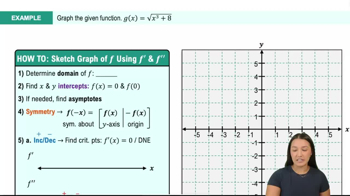Table of contents
- 0. Functions7h 52m
- Introduction to Functions16m
- Piecewise Functions10m
- Properties of Functions9m
- Common Functions1h 8m
- Transformations5m
- Combining Functions27m
- Exponent rules32m
- Exponential Functions28m
- Logarithmic Functions24m
- Properties of Logarithms34m
- Exponential & Logarithmic Equations35m
- Introduction to Trigonometric Functions38m
- Graphs of Trigonometric Functions44m
- Trigonometric Identities47m
- Inverse Trigonometric Functions48m
- 1. Limits and Continuity2h 2m
- 2. Intro to Derivatives1h 33m
- 3. Techniques of Differentiation3h 18m
- 4. Applications of Derivatives2h 38m
- 5. Graphical Applications of Derivatives6h 2m
- 6. Derivatives of Inverse, Exponential, & Logarithmic Functions2h 37m
- 7. Antiderivatives & Indefinite Integrals1h 26m
- 8. Definite Integrals3h 25m
5. Graphical Applications of Derivatives
Curve Sketching
Problem 3.6.56c
Textbook Question
{Use of Tech} Power and energy Power and energy are often used interchangeably, but they are quite different. Energy is what makes matter move or heat up. It is measured in units of joules or Calories, where 1 Cal=4184 J. One hour of walking consumes roughly 10⁶J, or 240 Cal. On the other hand, power is the rate at which energy is used, which is measured in watts, where 1 W=1 J/s. Other useful units of power are kilowatts (1 kW=10³ W) and megawatts (1 MW=10⁶ W). If energy is used at a rate of 1 kW for one hour, the total amount of energy used is 1 kilowatt-hour (1 kWh=3.6×10⁶ J) Suppose the cumulative energy used in a large building over a 24-hr period is given by E(t)=100t+4t²−t³ / 9kWh where t=0 corresponds to midnight.
c. Graph the power function and interpret the graph. What are the units of power in this case?
 Verified step by step guidance
Verified step by step guidance1
First, identify the energy function E(t) = (100t + 4t² - t³) / 9, where t is in hours. This function represents the cumulative energy used over time.
Next, to find the power function P(t), calculate the derivative of the energy function E(t) with respect to time t. This will give you the rate of change of energy, which is power.
Use the derivative formula: P(t) = dE/dt = (d/dt)(100t + 4t² - t³) / 9. Apply the power rule of differentiation to each term in the energy function.
After finding P(t), simplify the expression to obtain the power function in terms of t. This will help in understanding how power varies over the 24-hour period.
Finally, graph the power function P(t) over the interval from t = 0 to t = 24 hours. Analyze the graph to interpret how power usage changes throughout the day, noting the units of power in this case are kilowatts (kW).
Recommended similar problem, with video answer:
 Verified Solution
Verified SolutionThis video solution was recommended by our tutors as helpful for the problem above
Video duration:
3mPlay a video:
Was this helpful?

 11:41m
11:41mWatch next
Master Summary of Curve Sketching with a bite sized video explanation from Callie
Start learning




